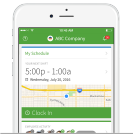The 8-Step Process for Boosting Customer Happiness & Loyalty
In today’s digital age, increasing customer loyalty should be at the top of every small business’ marketing strategy. Don’t get us wrong, acquiring new customers is important too, but your loyal customers will be your best assets. Not only are they a walking-talking-social media-sharing marketing campaign for your business or brand, but they typically apply to the 80/20 rule. That is, 80 percent of your revenue will come from 20 percent of your customers.
Before you can build brand advocates, you first need to know who your 20 percent is and what drives them to be loyal. Chances are what drives them to be loyal, is the same thing that will drive other customers to be loyal as well. The best place to start your research is with your point of sale system (POS).
Once you have found your 20 percent, you and your employees can follow these 8 steps to break the rules and create more happy and loyal customers.
#1 Start with the Golden Rule
This should go without saying, which is why we wanted to make it number one in this post. It’s something our mothers, fathers, teachers, and other influential adults have taught us our whole lives. Treat others how you want to be treated — with kindness, respect, and compassion.
In retail, the same type of theory applies: Treat your customers how you want to be treated when you’re the customer. Long before you were a business owner, you were, and still are a customer to many other businesses. Therefore, you already have a pretty good idea of what the customer side of you expects, likes and dislikes about other businesses you frequent. You know the reasons why you always shop at a particular store over another.
Now, as a business owner, your perception and awareness of being a customer should be heightened because you know what it’s like to be on both sides of the counter. You and your employees (more on them later) are your best resources for providing a positive and memorable experience for your customers. Increasing customer loyalty should start with the foundation of treating others, as you want to be treated. Then, put yourself in their shoes and start taking stock of how you would want to be treated as a customer in your own store.
Start your free 14-day trial of When I Work! Click here to start scheduling your employees today.

#2 Communication, Communication, Communication
Communication is another one that should go without saying, but we’re going to say it anyways because it’s important and will be a factor in all of the following steps.
Customers want to keep in touch with your business and know what’s going on, especially the loyal ones. It makes them feel like they are a part of a community, rather than just shelling out money for products every time they come into your store. Let them help you define what a positive customer experience means to them. There are formal and informal ways to go about this, which we will go into more detail later, but we want to emphasize that opening up communication with your customers is a big part of increasing customer loyalty. After all, these are the people that are keeping you in business so it’s only fair to keep them informed and to listen to what they have to say.
#3 Empower your Customers
It’s safe to say that every business owner knows more than the average customer about their specific industry or vertical. Customers look to you for advice about products or services. In their eyes, you are the expert. After all, that is why they are coming to you in the first place.
Don’t hold your knowledge hostage. Share it with your customers and showcase not only your expertise, but show that you’re invested in their success. For example, say you own a flower shop or nursery, share your knowledge about which blooms are best for which season in your region through an email or blog post. You can facilitate a DIY day for customers to come into your business and build a small seasonal planter. You could even partner with the local hardware store for some of the materials.
#4 Pricing for Transparency
Customers are pretty intuitive and can often see through the facade and shortcomings of a business. As a business owner, you want to make sure you put your best foot forward and are as open and honest about your business as possible.
A new catchphrase you may have heard that relates to this is ‘radical transparency,’ and a lot of companies are implementing it as part of their marketing strategy. Simply put, it means the company has made a conscious decision to openly share business insights and data, take ownership of flaws, and acknowledge details you normally wouldn’t share
One online retailer has had a lot of success following this model. Born by a passion for design and frustration about the lack of innovation in the retail industry, Michael Preysman created Everlane. The core of Everlane’s philosophy is radical transparency and visibility. Whenever you shop at their online store, you know exactly what your payment is going towards. For example, rather than offering a one-time price at the lowest possible price, they allow subscribers to pick their own sale price. Crazy, right? The twist is, they inform their customers what exactly they are paying for based on the price points. For example, they may sell an item that is regularly priced at $150 and their sale price point options would be $95, $110 and $125. When a customer selects the lowest price ($95), they are told their payment only covers the cost of production and shipping. If a customer selects the middle price point ($110), they are told the payment will cover production, shipping and overhead. If the customer selects the highest price point ($125), they are informed that their payment will not only cover production, shipping, and overhead but that it will also allow them to invest in their growth.
By creating this transparent approach, they found that their customers were more open to paying more to support the brand. A similar approach can easily be applied to traditional brick-and-mortar stores as well. When you put items on sale or clearance, let the customers know the value they are getting. For example, if you mark an item down 30 percent, let the customers know how that affects your business, margins, or bottom line.
#5 Hold Employees Accountable & Make Them Part of the Mission
While you may own the business, your employees are the face of it. They interact with customers the most, therefore, and have a direct impact on increasing customer loyalty and creating a positive customer experience. As a business owner, it is your job to hold them accountable to a high standard of creating a positive experience for customers.
One of the best ways to do that is to get them involved. Have a meeting. Have conversations and brainstorming sessions. Open the dialogue and find out what it means to them to have a positive customer experience and what they can do to re-create that for your customers. Combine that with your expertise and develop a standard and basic steps of service that employees are required to follow.
This will help create consistency across the board and your customers will come to know what to expect when they walk through the doors. Customers, like some people, don’t necessarily like change, so nothing says comfort to them like consistency.
#6 Ask for Feedback
This part definitely goes hand-in-hand with communication as a way of increasing customer loyalty. Opening the lines of communication is a two-way street. Not only do you want to communicate to customers about your business, but you also want to get their feedback.
The old fashioned way to do this is to simply talk to customers. Ask them what they think about your business, how they would rate their experience in your store, and what they would do to make it better.
It may be a little tricky to get candid feedback like this in person, so give your customers a more discreet way of providing feedback via an online form or email, or simply provide comment cards in store. Some customers will feel more comfortable and give you more productive feedback this way.
If you are struggling to get responses from customers, there are other ways to encourage feedback. Some businesses offer incentives such as gift cards or store credit to ‘one lucky winner’ that completes the survey as a way to entice customers to participate.
Since both methods have their advantages and disadvantages, the best way to get the most accurate results is to take a hybrid approach of both old school and new school communication practices.
Start your free 14-day trial of When I Work! Click here to start scheduling your employees today.

#7 Share the Love
Your customers literally keep you in business so it’s only right to show your gratitude for them by doing something they love and supporting the community around your business. Below are some ideas to get you started.
- Sponsor a local sports team such as a youth soccer team or an adult softball team.
- Hold an annual customer appreciation day at your business or nearby location and provide food and family style entertainment.
- Fundraise for a local charity or national charity that is near and dear to your customers’ hearts.
#8 Customer Appreciation
Rewarding customers for frequent shopping is pretty standard practice these days when it comes to ways of increasing customer loyalty. They walk into the store and make a purchase that translates into earned ‘points’ for the dollar amount spent. When they reach a certain amount of points, they are rewarded with a discount on a future purchase or a free item.
Since rewards are the norm, it doesn’t really set you apart from competitors or even other retailers in general, so you need to be a little more creative. Think outside the box and come up with other ways to show your customers you appreciate them. You could repurpose unsold inventory as free gifts or provide sweet treats at the counter to calm cranky children and delight stressed parents.
The possibilities are endless and only limited by your imagination. If you have a tough time getting started, check out these inexpensive customer appreciation ideas to get the creative juices flowing.
Increasing customer loyalty is a process, and just like all good things, it takes time to develop. Take these 8 steps as a starting point to see what works for your business, start applying them, and measure how much customer loyalty and happiness increase.






